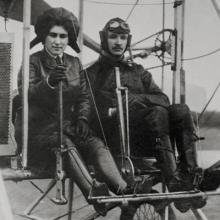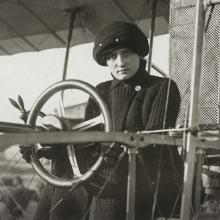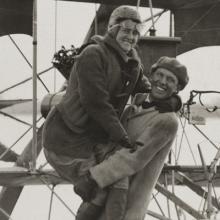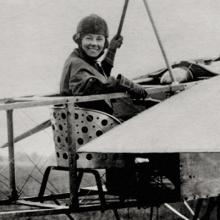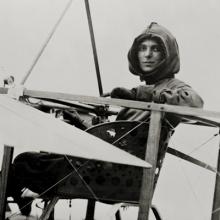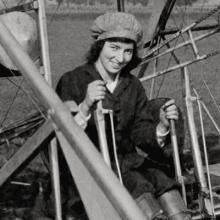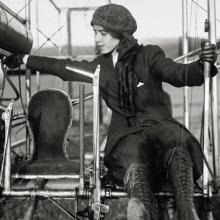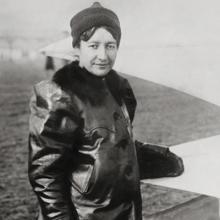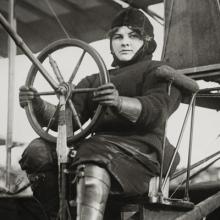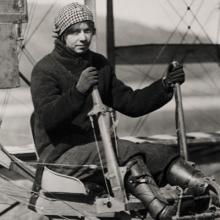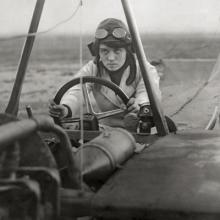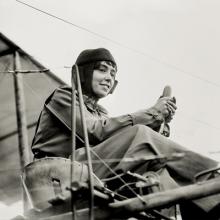Terminal 3














Eugenie Mikhailovna Shakhovskaya (1889–1920) and Vsevolod Mikhaylovich Abramovich (1890–1913) in Abramovich Flyer 1913
Bain News Service, New York City
Collection of Library of Congress, Washington, DC
LC-DIG-ggbain-13186
R2022.1401.009
Born into a wealthy Russian merchant family, Eugenie Mikhailovna Shakhovskaya married into the House of Romanov and became a princess. More interested in sports and mechanics than performing her royal duties, she desired to fly after attending an aviation meet in St. Petersburg in 1910. Unable to find instruction in Russia, Shakhovskaya traveled to Germany where she persuaded Russian pilot Vsevolod Abramovich to provide lessons. She earned her pilot’s license in 1912. Shortly after, she became an instructor at the German branch of the Wright Company. During World War I, Shakhovskaya flew reconnaissance missions for the Imperial Russian Air Force.
Raymonde de Laroche (1882–1919) at the controls of her Voisin biplane c. 1909
Roger B. Whitman Early Aviation Photograph Collection
Collection of National Air & Space Museum, Smithsonian Institution, Washington, DC
SI-2002-14069
R2022.1402.001
The French stage actor Raymonde de Laroche (1882–1919)—also known by the popular title of Baroness de Laroche—became the first woman to pilot an airplane in 1909. Instructed by Charles Voisin (1882-1912) in Chalons, France, she became the first woman to earn a pilot’s license, which was awarded by the Fédération Aéronautique Internationale in 1910. She subsequently participated in air meets in Europe, Russia, and Egypt, and won the Aero Club of France's Femina Cup for a non-stop long-distance flight in 1913. Shortly after World War I, she also established several altitude records and a flight distance record for women.
Lillian Janeway Atwater and William B. Atwater (1890–1937) in front of Curtiss seaplane, North Island, San Diego 1911
Harry A. (Alexander) Erickson (1884-1962)
Collection of DeGolyer Library, Southern Methodist University
Ag1982.0190
R2022.1405.002
Lillian Janeway Atwater was the first woman to fly a hydroplane in the United States. The widow of U.S. Senator Thomas C. Platt (1833–1910), she later married William B. Atwater and, in 1911, began hydroplane pilot training with her husband at the Curtiss School of Aviation in North Island, San Diego. It was reported that while at the school she caught a seagull in a net while her husband flew a hydroplane. She never earned a pilot’s license, and it remains unknown if she continued to fly after attending the school.
Julia Clark (1880–1912) at the controls of a Curtiss biplane c. 1912
Harry A. (Alexander) Erickson (1884-1962)
Collection of DeGolyer Library, Southern Methodist University
Ag1982.0190
R2022.1405.001
Michigan-born Julia Clark became interested in aviation in 1911, when she attended the Chicago International Aviation Meet. After first overcoming the reluctance of Glenn Curtiss to accept her as a student, she was allowed to train at the Curtiss School of Aviation in North Island, San Diego. In 1912, she became the third woman in the United States to earn a pilot’s license. She then joined the Curtiss exhibition team and was billed as "The Daring Bird-Girl."
Matilde Moisant (1878–1964) in her Moisant/Bleriot monoplane 1911
Collection of National Air & Space Museum, Smithsonian Institution, Washington, DC
SI-80-440
R2022.1402.002
Matilde Moisant was born in Indiana and was the sister of aviators John (1868–1910) and Alfred (1862–1929) Moisant. Instructed along with her friend Harriet Quimby (1875–1912) by aviator André Houpert (1886–1963) at her brother’s Moisant Aviation School in New York, Moisant earned her pilot’s license in 1911. She was only the second licensed woman aviator in the United States at the time. The same year, she broke the women’s altitude record at Garden City, New York. She toured briefly with the Moisant exhibition team before experiencing an accident in 1912. She retired from flying shortly after.
Harriet Quimby (1875–1912) in her Moisant/Bleriot monoplane 1911
Collection of Library of Congress, Washington, DC
LC-USZ62-15070
R2022.1401.005
In 1911, Harriet Quimby became the first woman in the United States to earn a pilot’s license. Born in Michigan, she moved to San Francisco as a teenager and wrote for several San Francisco newspapers, as well as Leslie's Illustrated Weekly. Trained by aviator André Houpert (1886–1963) at the Moisant Aviation School in New York in 1911, she earned her license shortly after and toured with the Moisant exhibition team. In 1912, she became the first woman to cross the English Channel in an airplane. Quimby was also the spokesperson for Vin Fiz, a grape-flavored beverage, and appeared in numerous advertisements for the drink dressed in a distinctive purple aviator uniform of her own design.
Bernetta Adams Miller (1884–1972) in a Moisant/Bleriot monoplane 1912
Harris & Ewing, Washington, DC
Collection of Library of Congress, Washington, DC
LC-DIG-hec-01546
R2022.1401.006
In 1912, Ohio-born Bernetta Adams Miller became the fifth woman in the United States to earn a pilot’s license. She learned to fly at the Moisant Aviation School in New York and afterward became the demonstration pilot for the Bleriot monoplanes built by the Moisant Company under license at this time. She became the first woman aviator to demonstrate an aircraft—and the first person to demonstrate a monoplane—to the U.S. government when she flew a Moisant/Bleriot for the U.S. Army at College Park, Maryland, in 1912.
Marjorie Stinson (1895–1975) at the controls of a Wright Model B biplane c. 1914
Collection of Wright State University Libraries’ Special Collections and Archives,
Wright Brothers Collection
ms1_20_8_2
R2022.1404.001
Marjorie Stinson was inspired to learn to fly by her sister Katherine Stinson. Trained at the Wright School in 1914 at the age of eighteen, she became the ninth woman in the United States to earn a pilot’s license. In 1915, Marjorie was the only woman flying in the U.S. Aviation Reserve Corps. She also trained cadets from the Royal Canadian Flying Corps for service in World War I and earned the nickname “The Flying Schoolmarm.” She was credited with training over one hundred pilots during the war.
Katherine Stinson (1891–1977) preparing a Wright Model B biplane for take-off c. 1913
William H. Trefts Jr.
Collection of Missouri History Museum, Photographs and Prints, William Trefts Collection
N29734
R2022.1403.001
Born in Alabama, Katherine Stinson could not initially find an instructor willing to train her, but ultimately persuaded Max Lillie (1881–1913) of the Wright School to give her lessons. In 1911, after just four hours of training, she was able to fly solo. In 1912, at the age of twenty-one, Stinson became the fourth woman in the United States to obtain a pilot’s certification. Often referred to as “the Flying School Girl,” Stinson quickly became a star aerobatic performer at air meets and exhibitions. The first woman to perform an aerial loop, she performed the stunt hundreds of times without a single mishap. She was also the first woman to fly the U.S. airmail and to perform flying exhibitions in China and Japan.
Marie Marvingt (1875–1963) c. 1910
Bain News Service, New York City
Collection of Library of Congress, Washington, DC
LC-DIG-ggbain-05523
R2022.1401.008
Before becoming a premier French aviator, Marie Marvingt was a mountaineer, a world-class athlete, and winner of numerous sport competitions. She learned to fly with Hubert Latham (1883–1912) in the Antoinette monoplane and in 1910 became the third woman to earn a pilot’s license in France. Shortly after, Marvingt, known as the “Fiancée of Danger,” set aviation records in time aloft and distance. Marvingt was also one of the earliest licensed female balloon pilots. In 1914, she became the first woman to cross the English Channel in a balloon. During World War I she was the only female French pilot allowed to fly in combat when she volunteered for bombing missions over Germany. She was awarded the Croix de Guerre for her service.
Blanche Scott (1884–1970) at the controls of her Curtiss biplane c. 1910
Bain News Service, New York City
Collection of Library of Congress, Washington, DC
LC-DIG-ggbain-12209
R2022.1401.003
Before becoming an aviator, Blanche Scott proved her automotive and mechanical skills by becoming the first woman to drive across the continent from New York to San Francisco in 1910. This feat brought her to the attention of Glenn H. Curtiss (1878–1930), who agreed to provide her with flying lessons. Curtiss fitted a limiter on her plane’s throttle to prevent flight during her training. Nonetheless, Scott became one of the first American women to fly solo in early September 1910 when either a gust of wind or movement of the limiter resulted in her ascent for a brief flight at an altitude of forty feet before she executed a gentle landing. Often billed as “the Flying Tomboy,” Scott became a professional aviator later the same year and was the first woman in America to perform at air meets. A highly skilled aviator and stunt pilot, Scott toured as a star performer with several exhibition teams. She also flew for Glenn L. Martin (1886–1955) as a test pilot.
Ruth Law (1887–1970) at the controls of her Curtiss biplane 1915
Collection of Library of Congress, Washington, DC
LC-USZ62-17971
R2022.1401.007
Massachusetts native Ruth Law was inspired to fly by her brother Rodman Law (1885–1919), a parachutist and stuntman. She was initially refused training from Orville Wright (1871–1948) because he believed women were not mechanically minded. She eventually persuaded Harry Atwood (1883–1967) and Arch Freeman (1890–1918) to instruct her in Saugus, Massachusetts. Law became the fifth woman in the United States to earn a pilot's license in 1912. During her flying career she set numerous records, including one for women’s altitude, and another for distance by either a male or female aviator in a flight from Chicago to New York in 1916. After World War I, she formed the Ruth Law Flying Circus and toured the United States. She retired from flying in 1922.
Amelie “Millie” Hedwig Beese (1886–1925) in a Rumpler Taube monoplane c. 1911
photograph
Collection of BundesArciv (German Federal Archives)
183-R20273
R2022.1406.001
In 1911, Amelie “Millie” Hedwig Beese became the first woman in Germany to earn a pilot’s license. Encouraged by her father, she developed an interest in aviation following Louis Blériot’s (1972–1936) first crossing of the English Channel in an aircraft in 1909. Beese initially trained under Robert Thelen (1884–1968). After an accident in an aircraft apparently sabotaged by another aviator, she later completed her instruction with Edmund Rumpler (1872–1940). She subsequently became a demonstration pilot for Rumpler’s Taube monoplane aircraft. In 1912, she opened a flight school with her future husband, French aviator Jean Charles Boutard (1884–1952).
Hélène Dutrieu (1877–1961) in her Farman biplane c. 1911
Bain News Service, New York City
Collection of Library of Congress, Washington, DC
LC-DIG-ggbain-09650
R2022.1401.002
Before becoming an aviator, the Belgian-born Hélène Dutrieu was a world-champion cyclist, an automobile racer, a stunt performer, and a comedic actor. She first flew in early 1910 and earned her pilot’s license from the Aéro-Club de Belgique (Aero Club of Belgium) the same year, becoming only the fourth woman aviator to be licensed. Known as the “Girl Hawk,” Dutrieu was the first winner of the Coupe Femina (Femina Cup) in 1910 and won it again the following year. In 1911, she won the Coppa del Re (King's Cup) race in Florence, Italy, besting fourteen other male aviators.
